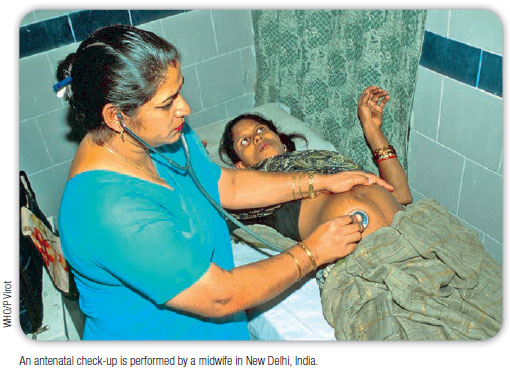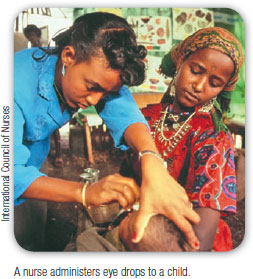NEWS
Wanted: 2.4 million nurses, and that's just in India
In most countries of the world there is a shortage of nurses but nowhere is it so acute as in the developing world. With International Nursing Day on 12 May 2010, Kathryn Senior investigates.
In every country, rich or poor, the story is the same. There are not enough nurses. The developed world fills itsvacancies by enticing nurses from other countries, while developing countries are unable to compete with better pay, better professional development and the lure of excitement offered elsewhere.
A World Bank report released in March describes the severity of the shortage of nurses in the Caribbean and Latin America alone. English-speaking Caribbean nations currently have 1.25 nurses for every 1000 people; 10 times fewer than countries in the European Union and the United States of America (USA). Around three in every 10 nursing positions currently remain unfilled and the report predicts that Caribbean countries will be short of 10 000 nurses to help care for their ageing population by 2025.
According to Deena Nardi, director of the Nurse Delegation Programme at the International Council of Nurses, the Caribbean is particularly prone to losing its nurses. "The global migration of nurses is particularly severe in smaller island nations such as Jamaica, where 8% of its generalist nurses and 20% of its specialist nurses leave for more developed countries each year," she says. Between 2002 and 2006, more than 1800 nurses left the Caribbean to work abroad. "People do not leave only for higher salaries - moving for better work conditions and the opportunity to progress professionally are also part of the problem."

"These 'push' factors are very hard to fix," says Christoph Kurowski, World Bank sector leader for human development, and author of the report.
Nardi stresses that the Caribbean countries are not an isolated example. "In Malawi, there are only 17 nurses for every 100 000 people," she says. In India, nurse shortages occur at every level of the healthcare system. AccordingtoDileep Kumar, chief nursing officer at the Ministry of Health and director of the Indian Nursing Council, 2.4 million nurses will be needed by 2012 to provide a nurse-patient ratio of one nurse per 500 patients.
"The data show that the states with the worst health-care human resource shortages are also the ones with the worst health indicators and highest infant and child mortality," says Nidhi Chaudhary, from the World Health Organization's office in New Delhi, India.
In Indonesia there is a shortage of nurses at health-care facilities but, in contrast with other countries, there are also many unemployed nurses. "The problem here is connected with mismanagement of nurse hiring and placement due to lack of resources," says Achir Yani Syuhaimie Hamid, president of the Faculty of Nursing at the University of Indonesia. According to the standards set by the Ministry of Health, the ideal ratio of nurses to patients in Indonesian hospitals is 2:1 to allow for shift working, 24-hour coverage and maternity- and sick-leave. "In reality there are only 500 nurses for every 500 beds," says Hamid.
Paucity of training is cited as one of the main reasons for the global nurse shortage. Nardi warns that in developing countries the focus of nurse training is often an issue, with curricula more suited to teaching skills useful in developed countries rather than in resource-poor settings in nurses' home countries."We see increasing student nurse attrition," she says.
Charlene Gyurko, of Purdue University, in Indiana, USA, thinks that another important factor is the shortage of well qualified nurse trainers. "The nursing faculty shortage is only partly due to global migration - faculty members tend to be older nurses and there is a reduced pool of younger nurses to replace them when they retire. The current trend is to rely on part-time nurse trainers, while reducing full-time faculty positions," she observes.
According to Dr Jean Yan, from the Health Professions Networks, Nursing and Midwifery unit at the World Health Organization, the faculty-student ratio in developing countries is reported to be as high as 1:45 compared with a 1:12 ratio in developed countries. "The chief nursing officer in Kenya tells us that the country has enough teaching staff to train just 100 nurses and midwives per year, at which rate it would take Kenya literally hundreds of years to preparethe required numberof nurses and midwives needed to provide quality health care to its population," she says.
In the Maldives, Aminath Saeed, deputy director of general nursing at the Maldives Nursing Council, reports that opportunities for career progression in nursing are limited. "Training facilities are poor and the profession is not attractive to the young people with potential in our country," she says. As many countries do, the Maldives is dealing with the shortfall by recruiting nurses from other countries.
In countries with widespread nurse shortages, the public health system does not have the capacity to contain a vector-borne illness or to control the spread of contagious diseases. "Treatments cannot be monitored, waiting times for any treatment are prolonged, patient education is not delivered, and patients wait in crowded rooms or sleep on floors. Diseases spread and the incidence of preventable diseases increase; we see this process recurring relentlessly especially where there is armed conflict," says Nardi, who notes that many initiatives that aim to improve nurse-to-patient ratios are already up and running. "A good example is Malawi's 'top-up' bonus for nurses, which aims to retain the country's nurses and support their professional development," she says.
The International Council of Nurses has established the International Nursing Education Network, a collaboration with the National League for Nursing in the USA to address the shortages of nurses and nursing educators that exists in many countries. The inaugural meeting was held in Durban, South Africa, in July 2009 at the International Council of Nurses' congress. "This network will create a forum for the global nursing education community to share resources in responding to the nursing shortage," predicts Nardi.
The World Health Organization has developed global standards for professional nursing and midwifery education based on the perspectives of more than 90 nursing associations, academic institutions and government bodies. These standards aim to raise the quality of nursing education and create paths for professional advancement in line with national, regional and global health needs.

In addition, the Bologna Process allows for academic exchange of comparable credits and degrees within the 46 European countries that are currently signatories. "For nursing, this could mean a collective improvement in professional and educational attainment globally," says Gyurko. The International Academic Nursing Alliance provides an electronic community for nursing trainers worldwide and offers a wide range of educational resources. The World Health Assembly has also adopted a resolution to develop a code of practice on international recruitment of health personnel to try to manage health workforce migration more effectively.
In India, some of the issues related to nurse retention still remain to be tackled - job insecurity for the contractual staff, low pay in both the government and private sectors, lack of a conducive work environment and infrastructure facilities. But, says Chaudhary, progress is being made. "Recently the cabinet approved the setting up of 260 government nursing schools at the district level to meet the shortage of nursing staff. The government has also increased the budgetary allocation for nursing education," she says.
Though nurse migration remains an issue, there has been some reduction in the number of new graduates leaving the profession. Nursing is considered a respectable profession by most sections male nurses has increased over the years, in contrast with the Maldives, which does not allow them. "Male nurses are preferred in the tribal areas, particularly in areas with difficult access," says Chaudhary. Some states have taken initiatives to promote male nurses. For example, Maharashtra State has reserved 20% of places in its nursing colleges for male students.

Recruiting nurses to rural areas also needs special attention. Recent research has shown that nurses in Kenya, South Africa and Thailand are receptive to different incentives to remain in nursing posts in rural areas; in Africa, nurses were more likely to accept a rural post with better educational opportunities or better pay due to rural allowances but Thai nurses regarded better health insurance coverage as the most important incentive. "Intervention packages tailored to local conditions are more likely to be effective than standardized global approaches," suggests Duane Blaauw, from the University of the Witwatersrand, Johannesburg, South Africa.
Leila McWhinney-Dehaney, now chief nursing officer in Jamaica, worked as a registered nurse midwife for 20 years. "Working in rural Jamaica uncovered for me the complexity of some health issues that rural people faced," she says. "I understood how much they relied on the health-care provider, especially nurses and midwives, to help them understand and deal with their health issues.
"The indomitable spirit of our people in deep rural areas was sometimes challenged by the high cost of transportation to both primary and secondary care facilities, and access to laboratory facilities and pharmaceuticals.This sometimes forced them to find alternative methods of treatment. As a nurse, I was often in a position to 'go the extra mile' to help patients access care." 
